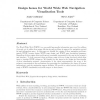Free Online Productivity Tools
i2Speak
i2Symbol
i2OCR
iTex2Img
iWeb2Print
iWeb2Shot
i2Type
iPdf2Split
iPdf2Merge
i2Bopomofo
i2Arabic
i2Style
i2Image
i2PDF
iLatex2Rtf
Sci2ools
RIAO
1997
1997
Design Issues for World Wide Web Navigation Visualisation Tools
The World Wide Web (WWW) is a successful hypermedia information space used by millions of people, yet it suffers from many deficiencies and problems in support for navigation around its vast information space. In this paper we identify the origins of these navigation problems, namely WWW browser design, WWW page design, and WWW page description languages. Regardless of their origins, these problems are eventually represented to the user at the browser’s user interface. To help overcome these problems, many tools are being developed which allow users to visualise WWW subspaces. We identify five key issues in the design and functionality of these visualisation systems: characteristics of the visual representation, the scope of the subspace representation, the mechanisms for generating the visualisation, the degree of browser independence, and the navigation support facilities. We provide a critical review of the diverse range of WWW visualisation tools with respect to these issues....
RIAO 1997 | RIAO 2007 | World Wide Web | WWW Page | WWW Page Design |
| Added | 01 Nov 2010 |
| Updated | 01 Nov 2010 |
| Type | Conference |
| Year | 1997 |
| Where | RIAO |
| Authors | Andy Cockbum, Steve Jones |
Comments (0)

